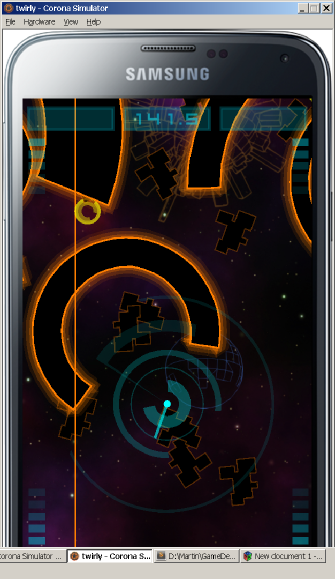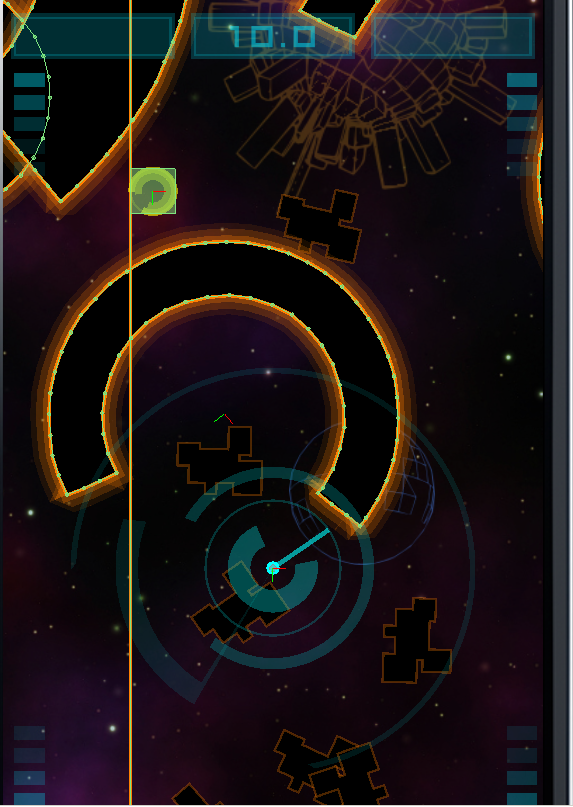Thanks for the replies all.
@roaminggamer
Thanks for the info! That link is very helpful, will try some things out, only rotating simpler shapes is also an option for me.
@Brent
I drew the ‘level’ in inkscape and used an inkscape extension to export the vertices
polygons ={ {680,972,678,953,674,933,668,914,659,896,648,880,636,864,621,851,605,839,588,829,570,821,551,815,531,812,511,812,494,813,477,816,461,821,445,827,451,841,458,855,474,848,490,844,507,842,524,842,541,844,559,849,575,856,591,865,605,876,617,889,628,904,637,920,644,937,648,954,649,972,649,974,649,989,646,1004,661,1008,676,1012,679,992}, {616,978,614,996,609,1015,601,1032,591,1047,577,1060,562,1071,545,1079,527,1084,508,1085,489,1084,471,1079,454,1071,439,1060,426,1047,415,1032,407,1015,402,996,401,978,402,959,407,941,415,924,426,909,439,895,454,885,471,877,489,872,508,870,527,872,545,877,562,885,577,895,591,909,601,924,609,941,614,959}, {341,966,340,986,342,1006,346,1025,353,1044,361,1062,372,1078,385,1094,399,1107,415,1119,433,1129,451,1137,470,1142,490,1145,507,1146,524,1144,541,1141,558,1137,553,1122,548,1108,531,1113,514,1115,497,1115,480,1113,464,1109,447,1103,431,1094,417,1083,404,1070,393,1056,384,1040,377,1023,373,1006,370,988,371,970,371,968,373,953,377,938,363,933,349,928,344,947}, {50,1407,55,1392,59,1377,63,1361,45,1356,29,1348,14,1337,2,1324,-8,1309,-16,1293,-21,1275,-23,1256,-21,1236,-15,1217,-6,1199,5,1183,19,1170,36,1159,54,1151,73,1148,92,1148,111,1151,129,1158,146,1167,161,1179,173,1194,183,1210,190,1228,191,1234,206,1231,222,1227,237,1224,235,1215,229,1197,221,1180,211,1164,199,1150,185,1137,170,1126,154,1116,137,1109,119,1104,100,1101,82,1100,63,1101,44,1105,27,1111,10,1119,-5,1129,-20,1141,-33,1155,-44,1170,-54,1186,-61,1203,-66,1221,-69,1240,-70,1259,-68,1277,-65,1296,-59,1313,-51,1330,-41,1346,-29,1361,-15,1374,0,1385,15,1395,32,1402} }
The I iterate through them and call this function passing in one set of vertices
local function createLevelPolygon(parent,vertices,strokeWidth,strokeAlpha,globalYOffset,isPhysics) local polygon = display.newPolygon( 0,0, vertices ) polygon:setFillColor(0) polygon.strokeWidth = strokeWidth polygon:setStrokeColor( colors.levelColor[1],colors.levelColor[2],colors.levelColor[3],strokeAlpha ) parent:insert(polygon) offsetObject(polygon,vertices) polygon.y = polygon.y + globalYOffset if isPhysics then physics.addBody( polygon , "static",{density=3.0,isSensor=true}) end table.insert(items, polygon) return polygon end
local function offsetObject(obj,vertices) local minX = math.huge local minY = math.huge local maxX = -math.huge local maxY = -math.huge for i=1, #vertices, 2 do local px = vertices[i] local py = vertices[i+1] if px \> maxX then maxX = px end if py \> maxY then maxY = py end if px \< minX then minX = px end if py \< minY then minY = py end end local centerX = (maxX - minX)/2 local centerY = (maxY - minY)/2 local offsetX = centerX + minX local offsetY = centerY + minY obj.x = obj.x+offsetX obj.y = obj.y+offsetY end
Thanks in advance for any help!


